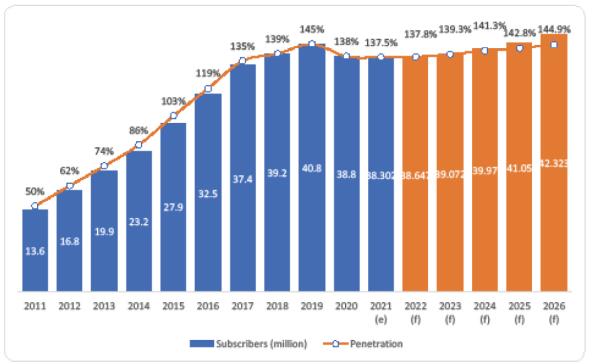08 April 2022

Efforts to expand Nepal’s telecom sector have faced many challenges over the years. For one, the country’s mountainous topography makes it extremely difficult (and costly) to build out the necessary infrastructure. Nepal has also struggled with a series of adverse economic situations, largely caused by political instability.
Sébastien de Rosbo,
research manager, BuddeComm
Because of the first major hurdle, Nepal’s fixed-line services are mainly concentrated in the Kathmandu area. Here, teledensity is substantially higher than the relatively meagre coverage available in rural regions. There has been some progress in recent years towards growing the national PSTN, based on a network of digital microwave links. Nepal Telecom has also been active in rolling out a fibre network between the major business areas and various district headquarters around the country. That being said, the overall penetration rate for fixed-line telephony services is still less than 3%. Most voice traffic is channeled via Nepal’s mobile networks.
Fixed broadband penetration has also been kept at a low level due to the lack of fixed-line infrastructure. While the government has initiated several programs (as part of the Digital Nepal Framework and the Optical Fibre Backbone Network Expansion Project) in an attempt to address this, however these initiatives have been plagued by delays and a general level of political apathy towards public investment in the sector. The private sector is now starting to take things into their own hands, with telcos investing in a range of fibre networks around the country, and competition is beginning to intensify. For example, low-cost fibre services launched by CG Net during 2021 prompted other ISPs to suddenly be able to provide faster and more competitively priced offers.

Table 1 – Growth in the number of mobile subscribers and penetration – 2011 – 2026
Source: BuddeComm based on regulator data
As fixed broadband coverage gradually improves, so too has demand for broadband services. This was particularly strongly felt during the Covid-19 pandemic, leading to an additional focus on international internet capacity. Most internet traffic is provided via India, with a few supplementary connections to China. But given Nepal’s difficult topographical conditions, these international connections are often disrupted by cable breaks. Pricing and availability is also at the whim of the Indian and Chinese telcos that are providing the capacity on the cables.

Source: BuddeComm based on regulator data
Source: BuddeComm based on regulator data
In contrast to the fixed-line market, Nepal is blessed with a relatively well-developed mobile segment. To date, the mobile operators have primarily been focusing on developing LTE networks. But in November 2021, Nepal Telecom received regulatory approval to begin trialing 5G services using spectrum in the 2600MHz band. According to telecom officials, commercial services could be launched as early as July 2022 (assuming those trials are successful).
Key developments:
Nepal Telecom begins 5G trials in five cities.
Nepal Telecom secures additional 1800MHz spectrum, and reveals plans to close down its WiMAX and CDMA networks.
The regulator allows telcos to re-farm 900MHz spectrum for LTE use.
Nepal’s first national satellite will be launched in 2022.
Nepal Telecom launches VoLTE services over its 4G network.






